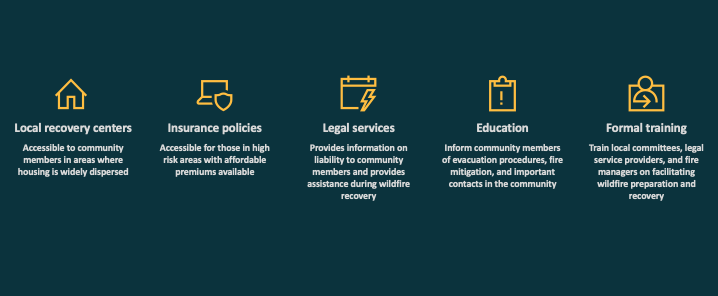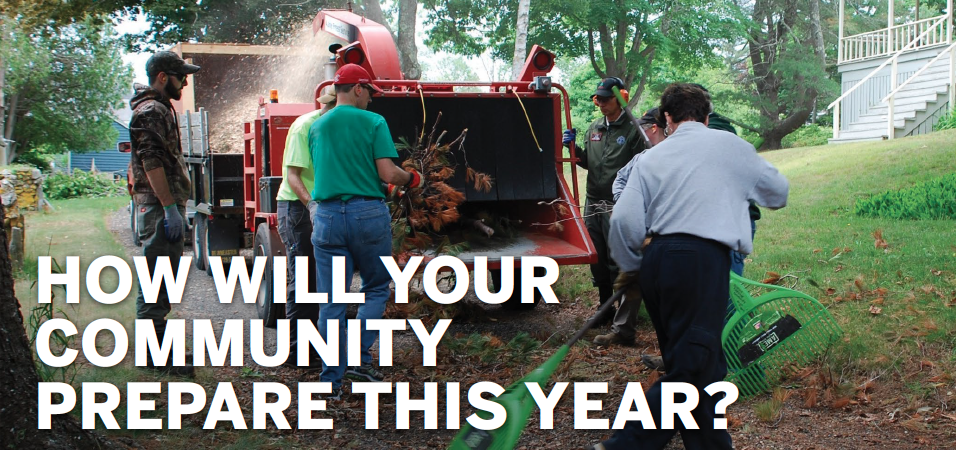FOR 531, Group 3
Key Points
- Fire frequency and severity has increased in the last decade due to increases in drought and tree mortality associated with total fire suppression and climate change.
- Rural communities face extremely high risk of severe wildfire. This risk is due in part to public push-back against active forest management. Push-back has contributed to the decline of the timber industry, allowing for more fuel accumulation and economically crippling rural communities by closing mills and eliminating a skilled labor force of loggers and mill employees.
- After a severe wildfire, these communities are in need of many resources including adequate temporary housing, unemployment compensation, medical expense payments, legal assistance, and access to food and water.
- Disaster relief frameworks, including insurance programs, need revision in order to capture the complexity of wildfire disaster relief in rural communities.
- Disaster relief resource managers should:
- Provide coordinated legal services
- Provide training for legal services/volunteers
- Educate and prepare communities for wildfire and its aftermath
- Rural communities should:
- Establish local committees to facilitate education and training for wildfire preparation and recovery
Executive Summary
Rural and low-income communities struggle to recover from and prepare for wildfires. This is a widespread risk, as around 12 million Americans live in areas that are prone to wildfire but are not capable of preparing for or recovering from a wildfire event (Richards 2019). The large number of people in fire-prone areas is partly a product of the recent influx of people into the Wildland Urban Interface (WUI), the setting of rural living. The WUI represents the fringe between developed areas and those areas outside of the framework of incorporated communities. By 2010, population levels within the WUI had grown to 98 million (see Table 1), and now 60% of all new home development is occurring within the WUI (Richards 2019).
Because rural communities often correspond to lower income (i.e. lower housing and land costs), many of the people residing in these areas struggle to recover after a wildfire. These areas have accumulated excess fuel in their dense understories after more than a century of wildfire suppression. Through this accumulation and recent economic hardship, rural communities are now at elevated risk of wildfires (Sierra Institute 2020). We hope this policy will serve as a guideline for state and local officials to help serve rural communities in the event of a wildfire.
Policy Recommendations

When confronting the aftermath of wildfire, rural communities need resources including adequate temporary housing, unemployment compensation, medical expense payments, legal assistance, and access to food and water. Disaster relief, including insurance programs, is currently insufficient in these situations and needs revision in order to capture the complexity of wildfire aftermath in rural communities. We recommend that disaster relief resource managers a) provide coordinated legal services, b) provide training for legal services and volunteers, and c) educate and prepare communities for wildfire. We also recommend that rural communities establish local committees to facilitate education and training for wildfire preparation and recovery. Improvements to these components of wildfire disaster preparation and response could greatly enhance the level of assistance and support experienced by rural landowners by providing them familiarity with risk and a framework for recovery.
The full length policy brief can be found here.
A presentation on the policy brief can be found here.

References
National Fire Protection Association (NFPA). 2020. Wildfire community preparedness day toolkit. Retrieved from https://www.nfpa.org/Public-Education/Fire-causes-and-risks/Wildfire/National-Wildfire-Community-Preparedness-Day
Richards, R. 2019. Before the fire: Protecting vulnerable communities from wildfire. Center for American Progress. https://www.americanprogress.org/issues/green/reports/2019/07/25/472639/before-thefire/
Sierra Institute. 2020. Fire, forests, and the future of rural communities. ArcGIS StoryMaps. https://www.arcgis.com/apps/Cascade/index.html?appid=2aa4e916e76943e2b5d84bd791be8fea